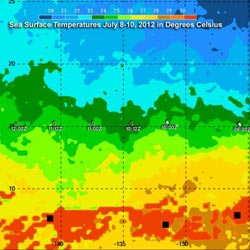NASA sees Tropical Storm Daniel move over cooler water

This analysis of sea surface temperatures is from July 8-10, 2012. Daniel's predicted path (shown in white) takes it over water with temperatures of about 24-25 C (~75.2 to 77.0 F). The boundary of 26 C (~79 F ) temperatures are shown in yellow on this analysis. Credit: Credit: NASA/SSAI, Hal Pierce<br>
The TRMM satellite flew above weakening tropical storm Daniel on July 10, 2012 at 0003 UTC. TRMM's Microwave Imager (TMI) and Precipitation Radar (PR) data from that pass showed that only light to moderate rainfall (.0.78 to 1.57 inches/20 to 40 mm/hour) was occurring with the weakening storm.
At NASA's Goddard Space Flight Center in Greenbelt, Md. Hal Pierce of the TRMM team created an analysis that showed averaged Sea Surface Temperatures (SST). The SST data was derived from TRMM Microwave Imager (TMI) data for the period from July 8-10, 2012. Daniel's predicted path takes it over water with temperatures of about 24-25 C (~75.2 to 77.0 F). Water needs to be around 26 C (~79 F ) to fuel a tropical cyclone so Daniel is predicted to gradually weaken to a tropical depression over the next couple days.
At 5 a.m. EDT on July 11, 2012 Tropical Storm Daniel had maximum sustained winds near 40 mph (65 kmh) and was moving to the west near 16 mph (26 kmh). Daniel was about 1,055 miles (1,700 km) east-southeast of Hilo, Hawaii near 15.4 North and 139.7 West. Satellite data indicates that only a small area of deep convection (rising air that form the thunderstorms that make up the tropical cyclone) remains south and southeast of Daniel's center.
When TRMM passed over Daniel on July 11 at 0858 UTC, it observed a few strong thunderstorms near Daniel's center of circulation reaching to heights of over 11km (~6.8 miles). Radar reflectivity values of almost 42 dBZ were being returned to TRMM PR indicating that moderate to heavy rainfall was occurring in that area.
Daniel is crossing over into the central Pacific Ocean today. On Friday the weakening tropical depression is expected to be south-southeast of the Hawaiian Islands.
Media Contact
More Information:
http://www.nasa.govAll latest news from the category: Earth Sciences
Earth Sciences (also referred to as Geosciences), which deals with basic issues surrounding our planet, plays a vital role in the area of energy and raw materials supply.
Earth Sciences comprises subjects such as geology, geography, geological informatics, paleontology, mineralogy, petrography, crystallography, geophysics, geodesy, glaciology, cartography, photogrammetry, meteorology and seismology, early-warning systems, earthquake research and polar research.
Newest articles

Sea slugs inspire highly stretchable biomedical sensor
USC Viterbi School of Engineering researcher Hangbo Zhao presents findings on highly stretchable and customizable microneedles for application in fields including neuroscience, tissue engineering, and wearable bioelectronics. The revolution in…

Twisting and binding matter waves with photons in a cavity
Precisely measuring the energy states of individual atoms has been a historical challenge for physicists due to atomic recoil. When an atom interacts with a photon, the atom “recoils” in…

Nanotubes, nanoparticles, and antibodies detect tiny amounts of fentanyl
New sensor is six orders of magnitude more sensitive than the next best thing. A research team at Pitt led by Alexander Star, a chemistry professor in the Kenneth P. Dietrich…





















